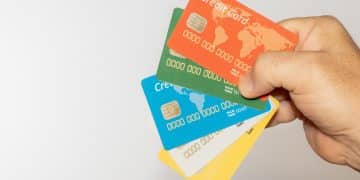Monitor credit card spending effectively to save money

Anúncios

Effective monitoring of credit card spending is a crucial part of financial management. It helps prevent overspending, protects you from accumulating debt, and ensures you stay within your budget.
Have you ever been shocked by how quickly those small expenses can add up? If you’re ready to take control of your finances and improve your spending habits, let’s explore some smart strategies to help you manage your credit card spending better.
Understanding Credit Card Spending: Key Insights for Better Financial Management
Credit card spending isn’t just about using your card to pay for items. It’s about understanding how the money you spend on your card can affect your overall financial situation.
From interest rates to spending limits, several key factors influence how your credit card works.
What is Credit Card Spending?
Credit card spending refers to the amount of money you charge to your credit card for various purchases, such as groceries, dining, entertainment, or even large items like electronics.
This spending accumulates over time, and if not managed properly, it can result in a high balance with interest charges that are difficult to pay off.
Key Factors to Consider When Managing Your Credit Card Spending
To fully understand how credit card spending affects your finances, you must consider several important factors that influence your total balance and payment obligations.
- Interest Rates: Credit cards often come with high-interest rates, and carrying a balance can significantly increase the amount you owe. Paying only the minimum balance means you will be charged interest on the remaining amount.
- Credit Limit: Your credit card has a maximum limit, and it’s essential to be mindful of it. Spending too close to or over your limit can negatively impact your credit score and lead to fees for exceeding the limit.
- Bill Payments: Timely bill payments are critical. Missing a payment can lead to late fees, increased interest rates, and damage to your credit score. Always ensure your payments are made on time to avoid unnecessary financial strain.
The Importance of Tracking Your Credit Card Spending
Monitoring your credit card spending is one of the best ways to keep your finances on track. By regularly checking your spending, you can identify where your money goes each month and categorize your expenses.
Tips for Effective Tracking:
- Separate Expenses: Categorizing your spending—such as food, utilities, and entertainment—can help you see where most of your money is going. This is especially important when trying to stick to a budget.
- Set Limits: Establish clear boundaries for each category to ensure you don’t overspend. For instance, set a monthly limit for dining out or groceries to keep your expenses manageable.
Creating a Credit Card Spending Plan
To avoid the pitfalls of overspending, creating a credit card spending plan is essential. A clear plan will help you make informed decisions about your purchases and ensure you stay within your budget.
Steps to Create a Spending Plan:
- List Your Monthly Income and Fixed Expenses: This includes your salary and any regular bills you must pay, like rent or insurance.
- Allocate Funds for Flexible Expenses: Decide how much you want to spend on items like groceries, entertainment, or dining out.
- Monitor Spending: Regularly track your spending, either by using mobile apps or checking your credit card statements. Tracking weekly helps you stay on top of your finances.
- Use Technology: Leverage budgeting apps or spreadsheet tools to categorize your expenses and track where your money goes.
- Review Monthly Statements: Always check your credit card statements for any discrepancies or unauthorized charges.
By staying aware of your credit card spending, you can make better choices about what to buy, when to buy it, and how much you should spend. This not only helps prevent financial strain but also promotes overall financial health.
Regular Reflection and Adjustment
It’s important to review your spending habits regularly. This helps you identify any spending patterns that may lead to unnecessary debt or financial stress.
Regular reflection can reveal areas where you could cut back, such as impulse purchases or subscriptions you no longer use.
By consistently tracking and adjusting your credit card spending, you can improve your financial situation over time.
Taking control of your spending today will lead to a more secure and less stressful financial future.
Why It Matters to Monitor Your Spending: Key Benefits for Financial Health
Monitoring your spending is a critical practice for anyone striving to achieve financial stability.
By keeping track of your expenses, you can make informed choices about your money, reduce unnecessary spending, and ultimately build better financial habits.
Let’s dive into the key reasons why it’s so important to monitor your spending and how it can benefit your overall financial health.
Preventing Debt
The primary reason to monitor your spending is to prevent debt. Without a clear picture of your credit card spending and other expenses, it’s easy to overspend, leading to accumulating debt that can become difficult to manage.
Regularly reviewing your spending habits ensures that you are staying within your means and not exceeding your budget.
When you have a better understanding of where your money goes each month, it’s easier to avoid unnecessary debt.
Being proactive about tracking your spending can help you steer clear of situations where debt piles up unexpectedly, giving you peace of mind and financial control.
Finding Unnecessary Expenses
Another benefit of monitoring your spending is that it helps you identify unnecessary expenses. You may be surprised by how many small, recurring purchases can add up over time.
For instance, buying coffee daily or subscribing to services you don’t use can drain your budget without you even realizing it.
- Example: Brewing your own coffee at home can save you hundreds of dollars each year.
- Tip: Review all your subscriptions and cancel those you no longer use or need.
- Consider: Direct the money you save toward savings or investments instead.
By actively tracking your credit card spending, you can uncover these hidden expenses and cut back where it matters most, allowing you to free up funds for more important financial goals, like building an emergency fund or saving for a future purchase.
Improving Financial Awareness
The more you monitor your spending, the more you understand your financial situation. This financial awareness is empowering, as it enables you to make better decisions about when to spend and when to save.
Knowing exactly where your money is going each month helps you make smarter choices about your finances.
This awareness also helps you plan for unexpected costs. By staying on top of your spending and having a clear understanding of your finances, you can set aside money for emergencies and avoid the stress of unexpected financial challenges.
It’s all about being prepared, both for the planned and the unplanned.
Building Better Financial Habits
Monitoring your spending fosters a sense of accountability, which can motivate you to stick to your budget.
When you regularly track your credit card spending, you have a clear view of your expenses, making it easier to stay on track with your financial goals.
This visibility can inspire better habits, like saving more, reducing impulse purchases, and avoiding unnecessary debt.
When you see the impact of your spending, it becomes easier to reflect on your habits and make adjustments. Over time, this leads to improved financial discipline, where you are more likely to make responsible decisions about your money.
Tools for Tracking Expenses: Effective Ways to Manage Your Spending

Using the right tools for tracking expenses can dramatically improve your financial management. With so many options available, it’s essential to find effective methods that help you stay organized and aware of where your money is going.
Let’s explore some of the best tools designed to help you track and manage your expenses effectively.
Mobile Apps for Expense Tracking
Mobile apps are one of the easiest and most convenient ways to track credit card spending and other expenses. These apps offer a range of features to help you monitor your spending habits, set budgets, and stay organized on the go.
Popular Mobile Apps:
- Mint: A free app that helps you categorize expenses, set budgets, and track your financial progress. It automatically pulls data from your bank accounts and credit cards, giving you a complete overview of your finances.
- YNAB (You Need A Budget): YNAB focuses on proactive budgeting, helping you allocate your funds wisely to ensure you stay within your limits. It also offers tools to help you plan for financial goals, such as saving for a vacation or building an emergency fund.
- PocketGuard: This app tracks your credit card spending and shows how much disposable income you have left after essential expenses. It helps you identify areas where you can cut back and save more money.
Mobile apps are ideal for people on the move, as they allow you to log expenses in real-time. Simply snap a picture of your receipt or enter an expense directly into the app, making it easy to stay on top of your budget throughout the day.
Spreadsheet Software for Customized Tracking
For those who prefer a more tailored approach to expense tracking, using spreadsheet software like Microsoft Excel or Google Sheets offers ultimate flexibility.
These tools allow you to create customized budgets and track your spending in ways that work best for you.
Advantages of Spreadsheet Software:
- Flexibility: You can design your own expense categories and track multiple sources of income and spending all in one place.
- Visualization: Spreadsheets allow you to create graphs and charts to visualize spending patterns, making it easier to spot trends over time.
- Automation: With basic formulas, you can automate calculations, such as totaling up expenses or calculating percentages for each category.
While setting up a spreadsheet may take some initial effort, it’s a great way to gain full control over your budget and spending habits. Once the template is set up, it can be easily updated and customized to fit your needs.
Expense Tracking Websites
If you prefer managing your finances from your desktop, several expense tracking websites can offer robust features for tracking credit card spending and other financial activities.
These platforms often sync directly with your bank accounts and credit cards, making it easier to monitor your spending without manually entering each transaction.
Popular Expense Tracking Websites:
- Personal Capital: Not only does this website track spending, but it also helps you with investment tracking and long-term financial planning. It provides a comprehensive view of your finances, allowing you to track both day-to-day expenses and your investment growth.
- EveryDollar: A straightforward tool designed for budget tracking. EveryDollar helps you create a monthly budget, plan for upcoming expenses, and monitor your spending habits throughout the month.
Web-based tools are excellent for those who prefer managing their finances from a desktop. These tools often provide detailed reports and interactive graphs to help you understand your spending habits at a deeper level.
Choosing the Right Tool for You
Whether you opt for mobile apps, spreadsheet software, or web-based platforms, the key to successful expense tracking is finding a tool that aligns with your lifestyle and financial needs.
The most effective tools are those you will use regularly, so choose one that fits your preferences and budget management style.
By regularly tracking your credit card spending and other expenses, you can build better financial habits and improve your financial awareness.
Consistency is the key to success, and using the right tool will help keep you accountable and on track to meet your financial goals.
Setting a Budget for Credit Card Use: A Guide to Smart Financial Management
Setting a budget for credit card use is an essential step in taking control of your finances. A well-structured budget helps you understand exactly how much you can afford to spend on your credit card without risking debt.
With a clear budget, you can make informed, conscious decisions about your purchases, ensuring they align with your financial goals.
Step 1: Determine Your Monthly Income
The first step in creating a budget for your credit card use is to identify your total monthly income. This includes your salary, any income from side gigs, freelance work, and any other sources of revenue.
Knowing exactly how much money you have coming in is crucial because it serves as the foundation for budgeting and ensures you don’t overspend.
- Fixed Income: This is your regular income, such as your salary or wages.
- Additional Income: Include income from freelance work, side jobs, or passive income streams.
Once you have a clear picture of your monthly income, you can allocate funds for various expenses, including your credit card spending.
Step 2: Identify Your Expenses
To set a realistic budget, it’s essential to outline all your fixed and variable expenses. Fixed expenses are costs that remain consistent each month, while variable expenses fluctuate depending on your lifestyle.
Fixed Expenses (must pay every month):
- Rent/Mortgage: Regular payments for housing.
- Insurance: Health, auto, or home insurance payments.
- Loan Payments: Car loans, student loans, and other recurring debt payments.
Variable Expenses (these may change from month to month):
- Groceries: Monthly spending on food.
- Dining Out: Money spent on eating out at restaurants or ordering takeout.
- Entertainment: Movies, events, and subscriptions like streaming services.
Additionally, don’t forget to account for an emergency fund. This fund serves as a financial cushion for unexpected expenses, such as medical bills or car repairs.
- Emergency Fund: Set aside some money each month for emergencies to avoid turning to credit cards when the unexpected happens.
Step 3: Set a Realistic Spending Limit for Your Credit Card Use
Now that you’ve identified your income and expenses, it’s time to set a spending limit for your credit card use. A common rule of thumb is to spend no more than 30% of your credit card’s total limit each month.
This helps keep your credit utilization rate low, which is an important factor for maintaining a good credit score.
- Credit Utilization: This refers to the percentage of your total available credit that you’re using. A low utilization rate is beneficial for your credit score and financial health.
When determining your spending limit, make sure it fits within your budget and does not jeopardize your ability to meet your other financial obligations, like paying bills or saving.
Step 4: Monitor Your Spending
Regularly tracking your spending is key to sticking to your credit card budget. By using budgeting apps or spreadsheets, you can record every expense and compare it to your set limits.
Monitoring helps you stay accountable and ensures that you’re on track to meet your financial goals.
Budgeting Tools to Help Monitor Spending:
- Apps: Use apps like Mint, YNAB (You Need A Budget), or PocketGuard to track your expenses and make adjustments as needed.
- Spreadsheets: Customize your own expense tracker with tools like Google Sheets or Microsoft Excel for greater flexibility.
If you notice that you’re overspending in certain categories, take immediate action to adjust your habits. For example, consider cutting back on dining out or finding less expensive entertainment options.
By making these small changes, you can free up funds for more important goals.
Step 5: Adjust Your Budget as Needed
A budget is a living document, meaning it should be adjusted regularly to reflect changes in your income, expenses, or goals. If you find that you’re consistently overspending in a particular category, it’s time to reevaluate and make adjustments.
Perhaps you need to reduce your credit card spending in one area to make room for another.
By reviewing your budget every month, you ensure that you’re on track to meet your financial goals and that your credit card use remains within a manageable and healthy limit.
Setting and sticking to a budget for credit card use is crucial for maintaining financial health and avoiding the stress of debt.
By understanding your income, identifying your fixed and variable expenses, and setting a reasonable spending limit for your credit card, you can ensure that your spending aligns with your financial goals.
Regularly monitoring your spending and adjusting your budget as needed will help you stay on track and continue making responsible financial decisions.
With discipline and consistent tracking, you can enjoy the benefits of credit card use without the burden of debt.
Recognizing Spending Patterns: A Key to Smart Financial Management

Recognizing spending patterns is a crucial part of managing your finances. When you understand how you spend your money, you can make more informed choices and adjust your habits accordingly.
It’s all about figuring out where your money goes each month and making sure that spending aligns with your financial goals.
Step 1: Track Your Expenses to Understand Spending Habits
The first step in recognizing spending patterns is to track your expenses. Start by logging every purchase you make for at least a month, no matter how small.
This means writing down everything, from your morning coffee to your larger purchases like rent or entertainment. By keeping a detailed record, you’ll be able to identify which purchases are consistent and which ones are spontaneous.
This practice provides a clear picture of your typical spending behavior and highlights areas where you might be overspending.
Tracking Tips:
- Write Everything Down: Don’t skip any expenses, no matter how insignificant they may seem.
- Track Consistently: Consistent tracking will provide a more accurate picture of your financial habits.
Step 2: Categorize Your Expenses
Once you have your expenses recorded, the next step is to categorize them. Grouping your spending into categories helps you see where your money is going and identify areas that may need adjustment.
Some common categories to consider include:
- Food: This includes grocery shopping, dining out, and takeout.
- Housing: Rent, mortgage payments, property taxes, and home insurance.
- Transportation: Gas, car payments, parking fees, or public transportation.
- Entertainment: Movies, subscriptions, events, and recreational activities.
Categorizing your expenses enables you to see which areas of your life take the largest portion of your budget. You may be surprised to find that you spend more on entertainment or food than you expected.
This recognition gives you the power to make adjustments, whether that means cooking at home more often or cutting back on subscription services.
Step 3: Spot Spending Trends Over Time
After categorizing your expenses, it’s time to look for trends. Do you tend to spend more at certain times of the month?
Many people find that their spending increases around paydays, holidays, or when they are feeling financially comfortable after a paycheck.
Recognizing these trends helps you plan for future expenses. For example, if you know that you tend to overspend during the holidays, you can plan ahead by saving more in the months leading up to them.
Tips for Spotting Trends:
- Track Monthly Patterns: Pay attention to any spikes in spending and try to identify the reason behind them.
- Adjust Your Budget Accordingly: If you notice you’re spending more at specific times, factor that into your monthly budget.
Visualizing Your Spending Patterns
One effective way to identify spending patterns is to create a visual chart. Tools like spreadsheets or budgeting apps can help you graph your expenses over time.
This visual representation makes it much easier to spot patterns and recognize areas where you might be overspending.
By creating charts or graphs, you can quickly see if you’re consistently exceeding your budget in specific categories.
This visual tool is an excellent way to stay on top of your credit card spending and other expenses, helping you keep your finances in check.
Step 4: Identify Impulse Purchases
As you analyze your spending habits, pay attention to impulse purchases. These spontaneous buys are often the root cause of overspending and can quickly derail your budget.
Impulse purchases, whether it’s an extra cup of coffee or an online shopping spree, can add up over time and cause you to exceed your spending limits.
Strategies to Combat Impulse Purchases:
- Implement a Cooling-Off Period: Before making a purchase, especially a large one, take 24-48 hours to reflect on whether you truly need the item.
- Set Limits: Decide in advance how much you’re willing to spend on non-essential items and stick to that limit.
Recognizing your tendency to make impulse purchases is a powerful way to adjust your behavior. By staying aware, you can develop better spending habits and avoid falling into the trap of overspending.
Empower Yourself with Financial Awareness
Recognizing spending patterns is a powerful tool for taking control of your finances. By tracking your expenses, categorizing them, and spotting trends, you gain valuable insights into your financial habits.
This awareness empowers you to make smarter decisions, adjust your habits, and create a budget that works for you.
By identifying areas where you can cut back and making small adjustments, you’ll be well on your way to better financial health.
Ultimately, recognizing your spending patterns gives you the ability to take charge of your money, reducing stress and putting you in control of your financial future.
Tips for Reducing Unnecessary Expenses: A Practical Guide to Smart Spending

Reducing unnecessary expenses is a vital step in managing your finances better. The less you spend on non-essential items, the more you can save for your goals. Here are some powerful tips to help you cut back on frivolous spending.
First, take a close look at your monthly subscriptions. Many people pay for services they seldom use, like streaming platforms or magazine subscriptions.
Consider cancelling those that do not add value to your life. You’d be surprised how much this can free up in your budget.
Implement a Waiting Period
Before making a purchase, especially if it’s a larger item, implement a waiting period of 24 to 48 hours. This pause gives you time to reflect on whether you truly need the item. Often, you may realize that the urge to buy has passed.
Prioritize Needs Over Wants
When shopping, prioritize your needs over your wants. Make a list before going to the store and stick to it. This helps you avoid impulse purchases and focus only on what is necessary.
- Essentials: Food, hygiene products, and necessary clothing.
- Non-essentials: New gadgets, luxury items, and trendy clothes.
Another effective strategy is to review your dining habits. Eating out can quickly drain your budget. Aim to cook at home more often. Not only is it cheaper, but it can also be healthier.
Meal prep for the week can help save time and reduce the temptation to eat out.
Take Advantage of Sales and Discounts
While shopping, look for sales and discounts that can help save money. However, only buy items you truly need, even if they are on sale. Buying a discounted item you wouldn’t normally buy is not a saving.
Additionally, consider using cashback apps or loyalty programs that reward you for shopping at certain places. This can provide some savings on purchases you already plan to make.
Reviewing your financial goals regularly can also motivate you to cut back on unnecessary expenses. Keep in mind what you are saving for, whether it be a holiday, a new car, or an emergency fund.
This mindset shift can encourage you to think twice before spending.
By following these tips, you can significantly reduce unnecessary expenses and make your budget work harder for you, ultimately enhancing your financial health.
Monitoring credit card spending effectively is a key factor in managing your finances and preventing debt. By utilizing tools, setting a budget, and recognizing spending patterns, you can take control of your finances and make smarter decisions with your money. It’s all about being proactive and staying disciplined.
To dive deeper into strategies for managing your credit card spending, check out the following resources:
By following these tips, you’ll be on your way to better financial health and less stress about your credit card spending!
FAQ – Frequently Asked Questions about Monitoring Credit Card Spending
Why is it important to monitor credit card spending?
Monitoring credit card spending helps prevent overspending and debt, allowing you to stay on track with your financial goals.
What tools can I use to track my expenses?
You can use budgeting apps, spreadsheets, or expense tracking websites to monitor your spending effectively.
How can I reduce unnecessary expenses?
Evaluate subscriptions, implement waiting periods before purchases, and prioritize needs over wants.
What is a good way to set a budget for credit card use?
Start by calculating your income, listing your expenses, and setting a limit on how much you can spend on your credit card each month.
Liked the article?





